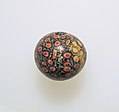Eye bead
Eye beads are glass beads with circular or point decorations . They are among the oldest known multicolored glass beads.
history
The oldest known and definitely dated eye pearls come from Egypt in the 15th century BC. Chr. And show a simple point decoration. They were made by melting a different-colored glass into the pearl body (matrix) . Early trade contacts between the eastern Mediterranean and Scandinavia are evidenced by an eye bead from the 14th century BC. BC, which was found in a grave in Jutland and which comes from Mesopotamia .
In Central Europe, the first eye pearls (ring eye pearls) come from the younger Urnfield Culture (Ha B) around 1050 BC. BC before, more often in the Iron Age . Whether these have already been manufactured in Central Europe or whether they have been imported is still the subject of scientific debates; more recent research results tend to suggest local production.
The oldest eye pearls found in central China from around 500 BC. BC are likely to have been imported from Egypt or Mesopotamia.
Eye beads are still used today, for example in the manufacture of Nazar amulets .
species
- Ring eye pearls: A circular glass thread was melted onto the different colored glass body.
- Spiral eye pearls: If the glass thread was applied as a spiral rather than being circular, one speaks of spiral eye pearls.
- Layered eye pearls: Layered eye pearls were widespread from the late Hallstatt period to the early La Tène period . For this purpose, one or more drops of different colored glass were applied concentrically in layers to a base bead and fused with the surface.
- Mosaic eye pearls (in older literature also sun pearls): These pearls, which are much more complex in production, were used in Egypt in the 1st century BC. And did not appear in Europe until the 8th century AD. For this purpose, a glass rod was successively coated with different colored molten glass and cut into pieces as it cooled. This resulted in prefabricated eyes, which were then melted into the heated pearl body. In some cases, pearls were also molded directly from the millefiori glass rod.
photos
Web links
literature
- Reinhard Andrae: Mosaikaugenperlen: Investigations on the distribution and dating of Carolingian millefiori glass beads in Europe . In: Adriaan von Müller, Gerdt Kutscher, Stephan Waetzold (eds.): Acta Praehistorica et Archaeologica . tape 4 . Bruno Hessling, Berlin 1975.
Individual evidence
- ^ A b Gustavus Eisen : The Characteristics of Eye Beads from the Earliest Times to the Present . In: Archaeological Institute of America (Ed.): American Journal of Archeology . tape 20 , no. 1 , 1916, p. 1–27 , doi : 10.2307 / 497200 (English).
- Jump up ↑ Jeanette Varberg, Bernard Gratuze, Flemming Kaul: Between Egypt, Mesopotamia and Scandinavia: Late Bronze Age glass beads found in Denmark . In: Elsevier (Ed.): Journal of Archaeological Science . tape 54 , 2015, p. 171, 174 , doi : 10.1016 / j.jas.2014.11.036 (English, article online at Academia.edu ).
- ^ Mildner, S., U. Schüssler, F. Falkenstein: Bronze Age glass between the Alpine ridge and the Baltic Sea. Investigations into the manufacture and distribution of the oldest glass in Central Europe . In: F. Schlütter, S. Greiff, M. Prange (eds.): Archaeometry and Monument Preservation 2012: Annual Conference at the Eberhard Karls University of Tübingen, 28.-31. March 2012, Metalla special issue 5 . Bochum 2012, p. 197–199 ( online on the website of the University of Würzburg (PDF; 578 kB)).
- ↑ Stephanie Mildner, Ulrich Schüssler, Frank Falkenstein, Helene Brätz: Bronze Age Glass in Western Central Europe - Finds, Composition and the Question of its Origin . In: Bianka Nessel, Immo Heske, Dirk Brandherm (ed.): Resources and raw materials in the Bronze Age: Use - Distribution - Control (work reports on the preservation of monuments in Brandenburg) . tape 26 . Brandenburg State Office for Monument Preservation, 2014, ISBN 978-3-910011-75-5 , p. 101 ( article online on the website of the University of Würzburg (PDF; 616 kB)).
- ↑ Fuxi Gan, Qinghui Li, Julian Henderson: Recent Advances in the Scientific Research on Ancient Glass and Glaze . In: Series on archeology and history of science in China . tape 2 . World Scientific, Singapore 2016, ISBN 978-981-4630-29-0 , pp. 11 ( limited preview in Google Book search).
- ↑ Johannes Hoops : Pearls . In: Reallexikon der Germanischen Altertumskunde . tape 22 . Walter de Gruyter, Berlin 1973, ISBN 978-3-11-017351-2 , p. 569 ( limited preview in Google Book search).
- ↑ Hunsrück Museum Simmern - Layered Eye Pearl. museum-digital , January 1, 2015, accessed on September 16, 2017 .



